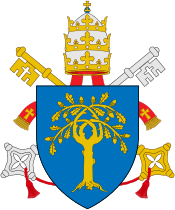Sistine Chapel ceiling
The Sistine Chapel ceiling (Italian: Volta della Cappella Sistina), painted by Michelangelo between 1508 and 1512, is a cornerstone work of High Renaissance art. The ceiling is that of the Sistine Chapel, the large papal chapel built within the Vatican between 1477 and 1480 by Pope Sixtus IV, for whom the chapel is named. It was painted at the commission of Pope Julius II. The chapel is the location for papal conclaves and many other important services.[1]
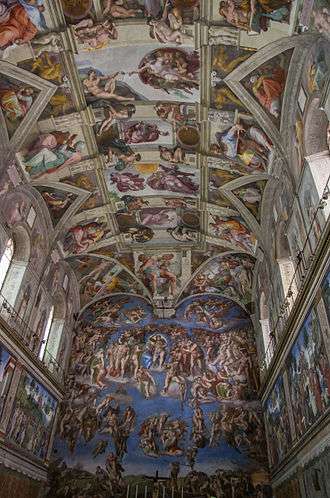
The ceiling's various painted elements form part of a larger scheme of decoration within the Chapel, which includes the large fresco The Last Judgement on the sanctuary wall, also by Michelangelo, wall paintings by several leading painters of the late 15th century including Sandro Botticelli, Domenico Ghirlandaio and Pietro Perugino, and a set of large tapestries by Raphael, the whole illustrating much of the doctrine of the Catholic Church.[2][3]
Central to the ceiling decoration are nine scenes from the Book of Genesis, of which The Creation of Adam is the best known, having an iconic standing equalled only by Leonardo da Vinci's Mona Lisa, the hands of God and Adam being reproduced in countless imitations. The complex design includes several sets of individual figures, both clothed and nude, which allowed Michelangelo to fully demonstrate his skill in creating a huge variety of poses for the human figure and which have provided an enormously influential pattern book of models for other artists ever since.
Context and history
Pope Julius II was a "warrior pope"[4] who in his papacy undertook an aggressive campaign for political control to unite and empower Italy under the leadership of the Church. He invested in symbolism to display his temporal power, such as his procession, in the Classical manner, through a triumphal arch in a chariot after one of his many military victories. It was Julius who began the rebuilding of St Peter's Basilica in 1506, as the most potent symbol of the source of papal power.[5]
Michelangelo left the Battle of Cascina unfinished when Pope Julius II (Giuliano della Rovere) summoned him to Rome in spring 1505 and commissioned him make his tomb in St Peter's Basilica.[6][7][8] Michelangelo and Pope Julius both had hot tempers and soon argued.[7][8] As Walter Pater, wrote, "Michelangelo was now thirty years old, and his reputation was established. Three great works fill the remainder of his life—three works often interrupted, carried on through a thousand hesitations, a thousand disappointments, quarrels with his patrons, quarrels with his family, quarrels perhaps most of all with himself—the Sistine Chapel, the Mausoleum of Julius the Second, and the Sacristy of San Lorenzo".[9] On 17 April 1506 Michelangelo left Rome in secret for Florence, remaining there until the Florentine government pressed him to return to the Pope.[8] In November 1506 he went instead to Bologna and constructed a colossal bronze statue of the Pope conquering the Bolognese.[8] (The Bolognese destroyed the bronze in 1511.)[8] The project of the papal tomb was quietly set aside, to be reinvigorated by the della Rovere family after his death.[7][8]
In 1506 Julius II began rebuilding St Peter's Basilica, which engaged his attention and by February 1513, when he died, little work had been done on his tomb.[10][6][7] It had been a grand commission, with 40 large figures to be carved.[7] Its original design was never begun.[8] Ultimately Michelangelo finished only three figures for the completed monument of 1545, reduced successively to a series of more modest designs, and built finally in the Church of San Pietro in Vincoli, including the c.1515 statue of Moses.[10][7][6] Two Slaves, the Bearded Slave and the Young Slave, c.1513, are in the Louvre.[10][6][7] The tomb commission lasted decades, and Michelangelo lamented, "I have wasted all my youth chained to this tomb."[10][6] Ascanio Condivi described the affair as the "Tragedy of the Tomb".[8]
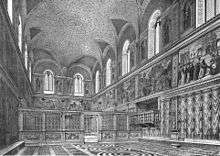
In spring 1508, Michelangelo returned to Rome to work on a cycle of frescoes on the vault and upper walls of the Sistine Chapel.[7][8] This work, also commissioned by Pope Julius II, "was equally daunting, but was brought to sublime fruition."[6][10] Michelangelo was reluctant to agree to the commission, preferring sculpture to painting, "but he made of it his most heroic achievement".[6][10] Initially he sought to engage assistants to speed along the onerous and unwelcome work as quickly as he could, but he was unable to find suitable candidates and painted nearly the whole ceiling alone.[8] Among the Florentine artists whom Michelangelo brought to Rome in the hope of assisting in the fresco, Giorgio Vasari named Francesco Granacci, Giuliano Bugiardini, Jacopo di Sandro, l'Indaco the Elder, Agnolo di Domenico, and Aristotile.[11]
Michelangelo began work in spring 1508, beginning at west end with the Drunkenness of Noah and the Prophet Zechariah and working backwards through the narrative to the Creation of Eve - in the vault's fifth bay and finished in September 1510.[8] The first half of the ceiling was unveiled officially on 15 August 1511; a long hiatus in painting occurred as new scaffolding was made ready.[8] Subsequently the second half of the ceiling's frescoes were done swiftly and the finished work revealed on 31 October 1512, All Hallows' Eve.[8][7]
After the revelation of the finished Sistine Chapel ceiling at the age of 37, Michelangelo's reputation rose such that was called Michelangelo il divino.[7][8] From then on, Michelangelo was recognized as the greatest artist of his time, who had elevated the status of the arts themselves, a recognition that lasted the rest of his long life, and his Sistine ceiling has always thereafter counted among the "supreme masterpieces of pictorial art".[6][8][10]
In 1506 Pope Julius conceived a programme to paint the ceiling of the Sistine Chapel.[12] The walls of the chapel had been decorated twenty years earlier. The lowest of three levels is painted to resemble draped hangings and was (and sometimes still is) hung on special occasions with a set of tapestries designed by Raphael. The middle level contains a complex scheme of frescoes illustrating the Life of Christ on the right side and the Life of Moses on the left side. It was carried out by some of the most renowned Renaissance painters: Botticelli, Ghirlandaio, Perugino, Pinturicchio, Signorelli and Cosimo Rosselli.[13] The upper level of the walls contains the windows, between which are painted pairs of illusionistic niches with representations of the first 32 popes.[14] A draft by Pier Matteo d'Amelia indicates that the ceiling was painted blue like that of the Arena Chapel and decorated with gold stars, possibly representing the zodiacal constellations. It is probable that, because the chapel was the site of regular meetings and Masses of an elite body of officials known as the Papal Chapel (who would observe the decorations and interpret their theological and temporal significance), it was Pope Julius' intention and expectation that the iconography of the ceiling was to be read with many layers of meaning.[15]
Michelangelo, who was not primarily a painter but a sculptor, was reluctant to take on the work; pope was adamant, leaving Michelangelo no choice but to accept.[16] However, a war with the French broke out, diverting the attention of the pope, and Michelangelo fled from Rome to continue sculpting. In 1508 the pope returned to Rome victorious and summoned Michelangelo to begin work on the ceiling. The contract was signed on 10 May 1508.[12]
The scheme proposed by the pope was for twelve large figures of the Apostles to occupy the pendentives.[17][18] However, Michelangelo negotiated for a grander, much more complex scheme and was finally permitted, in his own words, "to do as I liked".[19][lower-alpha 1] His scheme for the ceiling eventually comprised some three hundred figures and took four years to execute, being completed and shown to the public on All Saints' Day in 1512 after a preliminary showing and papal Mass on August 14, 1511.[12][16] It has been suggested that the Augustinian friar and cardinal, Giles of Viterbo, was a consultant for the theological aspect of the work.[20] Many writers consider that Michelangelo had the intellect, the biblical knowledge, and the powers of invention to have devised the scheme himself. This is supported by Ascanio Condivi's statement that Michelangelo read and reread the Old Testament while he was painting the ceiling, drawing his inspiration from the words of the scripture, rather than from the established traditions of sacral art.[21]
A total of 343 figures were painted on the ceiling.
Content
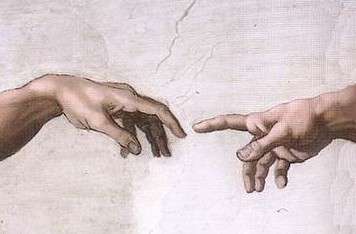
Michelangelo's frescoes form the back-story to the 15th century narrative cycles of the lives of Moses and Christ by Perugio and Botticelli on the Chapel's walls.[6][10] While the main central scenes depict incidents in the Book of Genesis, much debate exists on the multitudes of figures' exact interpretation.[10][6] The Sistine Chapel's ceiling is a shallow barrel vault around 35 m (118 ft) long and around 14 m (46 ft) broad.[8] The Chapel's windows cut into the vault's curve, producing a row of lunettes alternating with spandrels.[8]
Though Michelangelo claimed he eventually had a free hand in the artistic scheme, this claim was also made by Lorenzo Ghiberti about his monumental bronze doors for the Baptistery of Florence, for which it is known Ghiberti was constrained by stipulations on how the Old Testament scenes should appear and was able to decide merely the forms and number of the picture fields. It is likely that Michelangelo was free to choose forms and presentation of the design, but that the subjects and themes themselves were decided by the patron.[17]
The central, almost flat field of the ceiling is delineated by a fictive architectural cornice and divided into four large rectangles and five smaller ones by five pairs of painted ribs which cut laterally across the central rectangular field. These rectangles, which appear open to the sky, Michelangelo painted with scenes from the Old Testament.[8]
The narrative begins at the Chapel's east end, with the first scene above the altar, focus of the Eucharistic ceremonies performed by the clergy. The small rectangular field directly above the altar depicts the Primal Act of Creation. The last of the nine central fields, at the west end, shows the Drunkenness of Noah; below this scene is the door used by the laity.[8] Furthest from the altar, the Drunkenness of Noah represents the sinful nature of man.[8]
Above the cornice, at the four corners of each of the five smaller central fields, are nude male youths, called ignudi, whose precise significance is unknown.[8][10][6] Close to the sacred scenes in the uppermost register and unlike the figures of the lower register shown in perspective, they are not foreshortened.[8] They probably represent the Florentine Neoplatonists' view of humanity's ideal Platonic form, without the mar of Original Sin, to which the lower figures are all subject.[8] Kenneth Clark wrote that "their physical beauty is an image of divine perfection; their alert and vigorous movements an expression of divine energy".[23]
Below the painted cornice around the central rectangular area is a lower register depicting a continuation of the Chapel's walls as a trompe-l'œil architectural framework against which figures press, with powerful modelling.[8] The figures are drastically foreshortened and are at larger scale than the figures in the central scenes, "creating a sense of spatial disequilibrium".[8]
The ceiling at the Chapel's four corners forms a doubled spandrel painted with salvific scenes from the Old Testament: The Brazen Serpent, The Crucifixion of Haman, Judith and Holofernes, and David and Goliath.[8]
Each of the Chapel's window arches cuts into the curved vault, creating above each a triangular area of vaulting. The arch of each window is separated from the next by these triangular spandrels, in each of which are enthroned Prophets alternating with the Sibyls.[8][10][6] These figures, seven Old Testament prophets and five of the Graeco-Roman sibyls, were notable in Christian tradition for their prophesies of the Messiah or the Nativity of Jesus.[8] The lunettes above the windows are themselves painted with scenes of the "purely human" Ancestors of Christ, as are the spaces either side of each window. Their position is both the lowest in the vault and the darkest, in contrast with the airy upper vault.[8]
Interpretation
The overt subject matter of the ceiling is the Christian doctrine of humanity's need for Salvation as offered by God through Jesus. It is a visual metaphor of humankind's need for a covenant with God. The Old Covenant of the Children of Israel through Moses and the New Covenant through Christ had already been represented around the walls of the chapel.[2] Some experts, including Benjamin Blech and Vatican art historian Enrico Bruschini, have also noted less overt subject matter, which they describe as being "concealed" and "forbidden."[24][25]
On the crescent-shaped areas, or lunettes, above each of the chapel's windows are tablets listing the ancestors of Christ and accompanying figures. Above them, in the triangular spandrels, a further eight groups of figures are shown, but these have not been identified with specific biblical characters. The scheme is completed by four large corner pendentives, each illustrating a dramatic Biblical story.[26]
The narrative elements of the ceiling illustrate that God made the World as a perfect creation and put humanity into it, that humanity fell into disgrace and was punished by death and separation from God. Humanity then sank further into sin and disgrace, and was punished by the Great Flood. Through a lineage of ancestors – from Abraham to Joseph – God sent the saviour of humanity, Jesus Christ. The coming of the Saviour was prophesied by Prophets of Israel and Sibyls of the Classical world. The various components of the ceiling are linked to this Christian doctrine.[26] Traditionally, the Old Testament was perceived as a prefiguring of the New Testament. Many incidents and characters of the Old Testament were commonly understood as having a direct symbolic link to some particular aspect of the life of Jesus or to an important element of Christian doctrine or to a sacrament such as Baptism or the Eucharist. Jonah, for example, recognisable by his attribute of a great fish, was commonly seen to symbolize Jesus' death and resurrection.[3]
Much of the symbolism of the ceiling dates from the early church, but the ceiling also has elements that express the specifically Renaissance thinking that sought to reconcile Christian theology with the philosophy of Renaissance humanism.[27] During the 15th century in Italy, and in Florence in particular, there was a strong interest in Classical literature and the philosophies of Plato, Aristotle and other Classical writers. Michelangelo, as a young man, had spent time at the Platonic Academy established by the Medici family in Florence. He was familiar with early Humanist-inspired sculptural works such as Donatello's bronze David and had himself responded by carving the enormous nude marble David, which was placed in the Piazza della Signoria near the Palazzo Vecchio, the home of Florence's council.[28] The Humanist vision of humanity was one in which people responded to other people, to social responsibility, and to God in a direct way, not through intermediaries, such as the Church.[29] This conflicted with the Church's emphasis. While the Church emphasized humanity as essentially sinful and flawed, Humanism emphasized humanity as potentially noble and beautiful.[lower-alpha 2] These two views were not necessarily irreconcilable to the Church, but only through a recognition that the unique way to achieve this "elevation of spirit, mind and body" was through the Church as the agent of God. To be outside the Church was to be beyond Salvation. In the ceiling of the Sistine Chapel, Michelangelo presented both Catholic and Humanist elements in a way that does not appear visually conflicting. The inclusion of "non-biblical" figures such as the Sibyls or Ignudi is consistent with the rationalising of Humanist and Christian thought of the Renaissance. This rationalisation was to become a target of the Counter Reformation.
The iconography of the ceiling has had various interpretations in the past, some elements of which have been contradicted by modern scholarship.[lower-alpha 3] Others, such as the identity of the figures in the lunettes and spandrels, continue to defy interpretation.[30] Modern scholars have sought, as yet unsuccessfully, to determine a written source of the theological program of the ceiling and have questioned whether or not it was entirely devised by the artist himself, who was both an avid reader of the Bible and a genius.[31] Also of interest to some modern scholars is the question of how Michelangelo's own spiritual and psychological state is reflected in the iconography and the expression of the ceiling. One such speculation is that Michelangelo was tormented by conflict between his homosexuality and "his profound, almost mystical Catholicism."[lower-alpha 4]
Method

Michelangelo probably began working on the plans and cartoons for the design from April 1508.[32] The preparatory work on the ceiling was complete in late July the same year and on 4 February 1510 Francesco Albertini recorded Michelangelo had "decorated the upper, arched part with very beautiful pictures and gold".[32] The main design was largely finished in August 1510, as Michelangelo's texts suggest.[32] From September 1510 until February, June, or September 1511 Michelangelo did no work on the ceiling on account of a dispute over payments for work done; in August 1510 the Pope left Rome for the Papal States' campaign to reconquer Bologna and despite two visits there by Michelangelo resolution only came months after the Pope's return to Rome in June 1511. On 14 August 1511, on which day Pope Julius held a papal mass in the Chapel and the Pope saw the progress of the work so far for the first time.[32] This was the vigil for Assumption Day on the 15 August, the patronal feast on the Sistine Chapel.[32] The whole design was revealed to visitors on 31 October 1512 with a formal papal mass the following day, the feast of All Saints.[33] Clerical use of the Chapel continued throughout, exempting when the work on the scaffolding necessitated its closure, and disruption to the rites was minimized by beginning the work at the west end, furthest from the liturgical centre around the altar at the east wall.[32] Debate exists on what sequence the parts of the ceiling were painted in and over how the scaffold that allowed the artists to reach the ceiling was arranged. There are two main proposals.
The majority theory is that the ceiling's main frescoes were applied and painted in phases, with the scaffolding each time dismantled and moved to another part of the room, beginning at the Chapel's west end.[33] The first phase, including the central life of Noah, was completed in September 1509 and the scaffolding removed – only then were the scenes visible from the floor level.[33] The next phase, in the middle of the Chapel, completed the Creation of Eve and the Fall and Expulsion from Paradise. The Cumaean Sibyl and Ezekiel were also painted in this phase.[33] Michelangelo painted the figures at a larger scale than in the previous section; this is attributed to the artist's ability to effectively judge the foreshortening and composition from ground level for the first time.[33] The figures of the third phase, at the east end, were at still grander scale than the second; the Creation of Adam and the other Creation panels were finished at this stage, which took take place in 1511.[33] The lunettes above the windows were painted last, using a small movable scaffold.[33] In this scheme, proposed by Johannes Wilde, the vault's first and second registers, above and below the fictive architectural cornice, were painted together in stages as the scaffolding moved eastwards, with a stylistic and chronological break westwards and eastwards of the Creation of Eve.[32] After the central vault the main scaffold was replaced by a smaller contraction that allowed the painting of the lunettes, window vaults, and pendentives.[33] This view supplanted an older view that the central vault formed the first part of the work and was completed before work began on the other parts of Michelangelo's plan.[32]
Another theory is that the scaffolding must have spanned the entire Chapel for years at a time.[32] To remove the existing decoration of the ceiling, the entire area had to be accessible for workmen to chisel away the starry sky fresco before any new work was done.[32] On 10 June 1508 the cardinals complained of the intolerable dust and noise generated by the work; by the 27 July 1508 the process was complete and the corner spandrels of the Chapel had been converted into the doubled-spandrel triangular pendentives of the finished design.[32] Then the frame of the new designs had to be marked out on the surface when frescoeing began; this too demanded access to the whole ceiling.[32] This thesis is supported by the discovery during the modern restoration of the exact numbers of the giornate employed in the frescoes; if the ceiling was painted in two stages, the first spanning two years and extending to the Creation of Eve and the second lasting just one year, then Michelangelo would have to have painted 270 giornate in the one-year second phase, compared with 300 painted in the first two years, which is scarcely possible.[32] By contrast, if the ceiling's first register – with the nine scenes on rectangular fields, the medallions, and the ignudi – was painted in the first two years, and in the second phase Michelangelo painted only their border in the second register, with the Prophets and Sibyls, then the giornate finished in each year are divided almost equally.[32] Ulrich Pfisterer, advancing this theory, interprets Albertini's remark on "the upper, arched part with very beautiful pictures and gold" in February 1510 as referring only to upper part of the vault – the first register with its nine picture fields, its ignudi, and its medallions embellished with gold – and not to the vault as a whole, since the fictive architectural attic with its prophets and prophetesses were yet to be started.[32]
The scaffolding needed to protect the Chapel's existing wall frescoes and other decorations from falling debris and allow the religious services to continue below, but also to allow in air and some light from the windows below.[32] The Chapel's cornice, running around the room below the lunettes at the springing of the window arches themselves, supported the structure's oblique beams, while the carrying beams were set into the wall above the cornice using putlog holes.[32] This open structure supported catwalks and the movable working platform itself, whose likely stepped design followed the contour of the vault. Beneath was a false-ceiling that protected the Chapel.[32] Though some sun light would have entered the work space between the ceiling and the scaffolding, artificial light would have been required for painting, candlelight possibly influencing the appearance of the vivid colours used.[32]
Michelangelo designed his own scaffold, a flat wooden platform on brackets built out from holes in the wall near the top of the windows, rather than being built up from the floor. Mancinelli speculates that this was in order to cut the cost of timber.[34] According to Michelangelo's pupil and biographer Ascanio Condivi, the brackets and frame that supported the steps and flooring were all put in place at the beginning of the work and a lightweight screen, possibly cloth, was suspended beneath them to catch plaster drips, dust, and splashes of paint.[35] Only half the room was scaffolded at a time and the platform was moved as the painting was done in stages.[34] The areas of the wall covered by the scaffolding still appear as unpainted areas across the bottom of the lunettes. The holes were re-used to hold scaffolding in the latest restoration.
The entire ceiling is a fresco, which is an ancient method for painting murals that relies upon a chemical reaction between damp lime plaster and water-based pigments to permanently fuse the work into the wall.[36] Michelangelo had been an apprentice in the workshop of Domenico Ghirlandaio, one of the most competent and prolific of Florentine fresco painters, at the time that the latter was employed on a fresco cycle at Santa Maria Novella and whose work was represented on the walls of the Sistine Chapel.[37] At the outset, the plaster, intonaco, began to grow mould because it was too wet. Michelangelo had to remove it and start again. He then tried a new formula created by one of his assistants, Jacopo l'Indaco, which resisted mould and entered the Italian building and fresco tradition.[35]

Because he was painting affresco, the plaster was laid in a new section every day, called a giornata. At the beginning of each session, the edges would be scraped away and a new area laid down.[34] The edges between giornate remain slightly visible; thus, they give a good idea of how the work progressed. It was customary for fresco painters to use a full-sized detailed drawing, a cartoon, to transfer a design onto a plaster surface—many frescoes show little holes made with a stiletto, outlining the figures. Here Michelangelo broke with convention; once confident the intonaco had been well applied, he drew directly onto the ceiling. His energetic sweeping outlines can be seen scraped into some of the surfaces,[lower-alpha 5] while on others a grid is evident, indicating that he enlarged directly onto the ceiling from a small drawing.
Michelangelo painted onto the damp plaster using a wash technique to apply broad areas of colour, then as the surface became drier, he revisited these areas with a more linear approach, adding shade and detail with a variety of brushes. For some textured surfaces, such as facial hair and wood-grain, he used a broad brush with bristles as sparse as a comb. He employed all the finest workshop methods and best innovations, combining them with a diversity of brushwork and breadth of skill far exceeding that of the meticulous Ghirlandaio.[lower-alpha 6]
The work commenced at the end of the building furthest from the altar, with the latest of the narrative scenes, and progressed towards the altar with the scenes of the Creation.[20] The first three scenes, from The Drunkenness of Noah, contain smaller figures than the later panels. This is partly because of the subject matter, which deals with the fate of Humanity, but also because Michelangelo underestimated the ceiling's scale.[26][38] Also painted in the early stages was the Slaying of Goliath.[39] After painting the Creation of Eve adjacent to the marble screen which divided the chapel,[lower-alpha 7] Michelangelo paused in his work to move the scaffolding to the other side. After having seen his completed work so far, he returned to work with the Temptation and Fall, followed by the Creation of Adam.[40][38] As the scale of the work got larger, Michelangelo's style became broader; the final narrative scene of God in the act of creation was painted in a single day.[41]
The bright colours and broad, cleanly defined outlines make each subject easily visible from the floor. Despite the height of the ceiling, the proportions of the Creation of Adam are such that when standing beneath it, "it appears as if the viewer could simply raise a finger and meet those of God and Adam". Vasari tells us that the ceiling is "unfinished", that its unveiling occurred before it could be reworked with gold leaf and vivid blue lapis lazuli as was customary with frescoes and in order to better link the ceiling with the walls below, which were highlighted with a great deal of gold. But this never took place, in part because Michelangelo was reluctant to set up the scaffolding again, and probably also because the gold and particularly the intense blue would have distracted from his painterly conception.[16] Michelangelo's patron and the ceiling's commissioner, Pope Julius II, died only months after the ceiling's completion, in February 1513.[33]
According to Vasari and Condivi, Michelangelo painted in a standing position, not lying on his back, as another biographer Paolo Giovio imagined.[42] Vasari wrote: "The work was carried out in extremely uncomfortable conditions, from his having to work with his head tilted upwards".[16] Michelangelo may have described his physical discomfort in a poem, accompanied by a sketch in the margin, which was probably addressed to the humanist academician Giovanni di Benedetto da Pistoia, a friend with whom Michelangelo corresponded.[42] Leonard Barkan compared the posture of Michelangelo's marginalia self-portrait to the Roman sculptures of Marsyas Bound in the Uffizi Gallery; Barkan further connects the flayed Marsyas with Michelangelo's purported self-portrait decades later on the flayed skin of St Bartholomew in his Last Judgement but cautions that there is no certainty the sketch represents the process of painting the Chapel ceiling.[43] Michelangelo wrote his poem "I' ho già fatto un gozzo" describing the arduous conditions under which he worked; the manuscript is illustrated with a sketch - likely of the poet painting the ceiling:
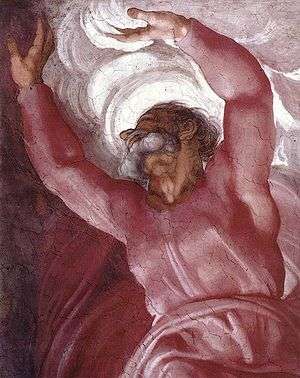
I’ ho già fatto un gozzo in questo stento, |
I've grown a goitre by dwelling in this den– |
| —№ 5. "A Giovanni quel propio da Pistoia" | —№ 5: To Giovanni a Pistoia - On the Painting of the Sistine Chapel, trans. John Addington Symonds, 1878 |
.jpg)
Architectural scheme
Real
The Sistine Chapel is 40.9 metres (134 ft) long and 14 metres (46 ft) wide. The ceiling rises to 13.4 metres (44 ft) above the main floor of the chapel. The vault is of quite a complex design and it is unlikely that it was originally intended to have such elaborate decoration. Pier Matteo d'Amelia provided a plan for its decoration with the architectural elements picked out and the ceiling painted blue and dotted with gold stars, similar to that of the Arena Chapel decorated by Giotto at Padua.[46]
The chapel walls have three horizontal tiers with six windows in the upper tier down each side. There were also two windows at each end, but these have been closed up above the altar when Michelangelo's Last Judgement was painted, obliterating two lunettes. Between the windows are large pendentives which support the vault. Between the pendentives are triangularly shaped arches or spandrels cut into the vault above each window. Above the height of the pendentives, the ceiling slopes gently without much deviation from the horizontal.[46] This is the real architecture. Michelangelo has elaborated it with illusionary or fictive architecture.

Illusionary

The first element in the scheme of painted architecture is a definition of the real architectural elements by accentuating the lines where spandrels and pendentives intersect with the curving vault. Michelangelo painted these as decorative courses that look like sculpted stone mouldings.[lower-alpha 8] These have two repeating motifs, a formula common in Classical architecture.[lower-alpha 9] Here, one motif is the acorn, the symbol of the family of both Pope Sixtus IV, who built the chapel, and Pope Julius II, who commissioned Michelangelo's work.[lower-alpha 10][47] The other motif is the scallop shell, one of the symbols of the Madonna, to whose Assumption the chapel was dedicated in 1483.[lower-alpha 11][48] The crown of the wall then rises above the spandrels, to a strongly projecting painted cornice that runs right around the ceiling, separating the pictorial areas of the biblical scenes from the figures of prophets, sibyls, and ancestors, who literally and figuratively support the narratives. Ten broad painted cross-ribs of travertine cross the ceiling and divide it into alternately wide and narrow pictorial spaces, a grid that gives all the figures their defined place.[49]
A great number of small figures are integrated with the painted architecture, their purpose apparently purely decorative. These include pilasters with capitals supported by pairs of infant telamones, rams' skulls are placed at the apex of each spandrel like bucrania; bronze nude figures in varying poses, hiding in the shadows, propped between the spandrels and the ribs like animated bookends; and more putti, both clothed and unclothed, strike a variety of poses as they support the nameplates of the Prophets and Sibyls.[50] Above the cornice and to either side of the smaller scenes are an array of medallions, or round shields. They are framed by a total of twenty more figures, the so-called ignudi, which are not part of the architecture but sit on plinths, their feet planted convincingly on the fictive cornice. Pictorially, the ignudi appear to occupy a space between the narrative spaces and the space of the chapel itself. (see below)
Michelangelo's scheme realized
Pictorial scheme
Nine scenes from the Book of Genesis
Along the central section of the ceiling, Michelangelo depicted nine scenes from the Book of Genesis, the first book of the Bible. The pictures are organized into three groups of three alternating large and small fields or picture panels.[51]
The first group shows God creating the Heavens and the Earth. The second group shows God creating the first man and woman, Adam and Eve, and their disobedience of God and consequent expulsion from the Garden of Eden where they have lived and where they walked with God. The third group of three pictures shows the plight of Humanity and in particular the family of Noah.
The pictures are not in strictly chronological order. If they are perceived as three groups, then the pictures in each of the three units inform upon each other, in the same way as was usual in Mediaeval paintings and stained glass.[52] The three sections of Creation, Downfall, and Fate of Humanity appear in reverse order, when read from the entrance of the chapel. However, each individual scene is painted to be viewed when looking toward the altar.[51] This is not easily apparent when viewing a reproduced image of the ceiling but becomes clear when the viewer looks upward at the vault. Paoletti and Radke suggest that this reversed progression symbolizes a return to a state of grace.[51] However, the three sections are generally described in the order of Biblical chronology.
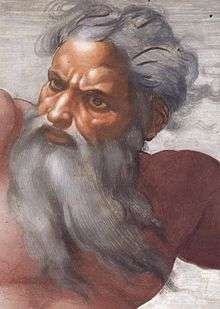
The scenes, from the altar toward the main door, are ordered as follows:
- The Separation of Light from Darkness
- The Creation of the Sun, Moon and Plants
- The Separation of Land and Water
- The Creation of Adam
- The Creation of Eve
- The Fall and Expulsion
- The Sacrifice of Noah
- The Great Flood
- The Drunkenness of Noah
.jpg)

Creation
The three creation pictures show scenes from the first chapter of Genesis, which relates that God created the Earth and all that is in it in six days, resting on the seventh day. In the first scene, the First Day of Creation, God creates light and separates light from darkness.[Fig 1] Chronologically, the next scene takes place in the third panel, in which, on the Second Day, God divides the waters from the heavens.[Fig 2] In the central panel, the largest of the three, there are two representations of God. On the Third Day, God creates the Earth and makes it sprout plants. On the Fourth Day, God puts the Sun and the Moon in place to govern the night and the day, the time and the seasons of the year.[Fig 3] According to Genesis, on the Fifth Day, God created the birds of the air and fish and creatures of the deep, but we are not shown this. Neither do we see God's creation of the creatures of the earth on the Sixth Day.[12][Src 1]
These three scenes, completed in the third stage of painting, are the most broadly conceived, the most broadly painted and the most dynamic of all the pictures. Of the first scene Vasari says "... Michelangelo depicted God dividing Light from Darkness, showing him in all his majesty as he rests self-sustained with arms outstretched, in a revelation of love and creative power."[16]
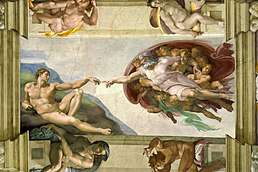
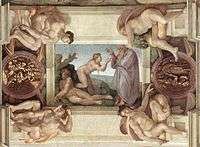
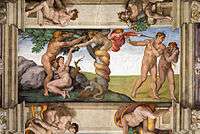
Adam and Eve
For the central section of the ceiling, Michelangelo has taken four episodes from the story of Adam and Eve as told in the first, second and third chapters of Genesis. In this sequence of three, two of the panels are large and one small.
In the first of the pictures, one of the most widely recognized images in the history of painting, Michelangelo shows God reaching out to touch Adam; in the words of Vasari, "a figure whose beauty, pose and contours are such that it seems to have been fashioned that very moment by the first and supreme creator rather than by the drawing and brush of a mortal man."[16] From beneath the sheltering arm of God, Eve looks out, a little apprehensively.[26] Correspondingly, Adam reaches out to the creator "as he comes with the forms of things to be, woman and her progeny, in the fold of his garment".[53] On the figure of Adam in the Creation, Walter Pater wrote:[54]
Fair as the young men of the Elgin marbles, the Adam of the Sistine Chapel is unlike them in a total absence of that balance and completeness which express so well the sentiment of a self-contained, independent life. In that languid figure there is something rude and satyr-like, something akin to the rugged hillside on which it lies. His whole form is gathered into an expression of mere expectation and reception; he has hardly strength enough to lift his finger to touch the finger of the creator; yet a touch of the finger-tips will suffice.
— Walter Pater, The Renaissance: Studies in Art and Poetry, "The Poetry of Michelangelo"
The central scene, of God creating Eve from the side of the sleeping Adam[Fig 4] has been taken in its composition directly from another creation sequence, the relief panels that surround the door of the Basilica of San Petronio, Bologna by Jacopo della Quercia whose work Michelangelo had studied in his youth.[55][56] In the final panel of this sequence Michelangelo combines two contrasting scenes into one panel,[Fig 5] that of Adam and Eve taking fruit from the forbidden tree (a fig and not an apple tree as commonly depicted in Western Christian art),[57] Eve trustingly taking it from the hand of the Serpent (depicted as Lilith) and Adam eagerly picking it for himself; and their banishment from the Garden of Eden, where they have lived in the company of God, to the world outside where they have to fend for themselves and experience death.[12][Src 2]
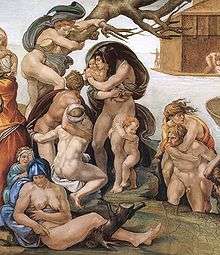
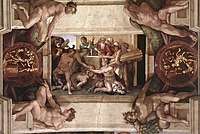
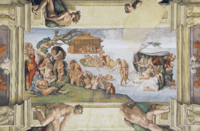

Noah
As with the first sequence of pictures, the three panels concerning Noah, taken from the sixth to ninth chapters of Genesis are thematic rather than chronological. In the first scene is shown the sacrifice of a sheep.[Fig 6] Vasari, in writing about this scene mistakes it for the sacrifices by Cain and Abel, in which Abel's sacrifice was acceptable to God and Cain's was not. What this image almost certainly depicts is the sacrifice made by the family of Noah, after their safe deliverance from the Great Flood which destroyed the rest of humanity.
The central, larger, scene shows the Great Flood.[Fig 7] The Ark in which Noah's family escaped floats at the rear of the picture while the rest of humanity tries frantically to scramble to some point of safety. This picture, which has a large number of figures, conforms the most closely to the format of the paintings that had been done around the walls.
The final scene is the story of Noah's drunkenness.[Fig 8] After the Flood, Noah tills the soil and grows vines. He is shown doing so, in the background of the picture. He becomes drunk and inadvertently exposes himself. His youngest son, Ham, brings his two brothers Shem and Japheth to see the sight but they discreetly cover their father with a cloak. Ham is later cursed by Noah and told that the descendants of Ham's son Canaan will serve Shem and Japheth's descendants forever. Taken together, these three pictures serve to show that humankind had moved a long way from God's perfect creation. However, it is through Shem and his descendants, the Israelites, that Salvation will come to the world.[Src 3]
Since Michelangelo executed the nine Biblical scenes in reverse chronological order, some analyses of the frescoes of the vault commence with the Drunkenness of Noah. Tolnay's Neoplatonic interpretation sees the story of Noah at the beginning and the act of creation by God as the conclusion of the process of deificatio and the return from physical to spiritual being.[58]
Medallions
Adjacent to the smaller Biblical scenes in the first register and supported by the paired ignudi are ten medallions. Each is decorated with a picture drawn from the Old Testament.
Michelangelo's obscure Old Testament themes were adapted from the wood-cut illustrations of the 1490 Malermi Bible, the first Italian-language Bible named after its translator Nicolò Malermi.[59] In four of the five most highly finished medallions the space is crowded with figures in violent action, similar to Michelangelo's cartoon for the Battle of Cascina.
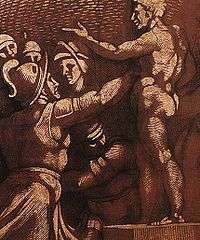
The medallions represent:
- Abraham about to sacrifice his son Isaac
- The Destruction of the Statue of Baal
- The worshippers of Baal being brutally slaughtered.
- Uriah being beaten to death.[Fig 9]
- Nathan the priest condemning King David for murder and adultery.
- King David's traitorous son Absalom caught by his hair in a tree while trying to escape and beheaded by David's troops.
- Joab sneaking up on Abner to murder him
- Joram being hurled from a chariot onto his head.
- Elijah being carried up to Heaven
- On one medallion the subject is either obliterated or incomplete.[Fig 10]
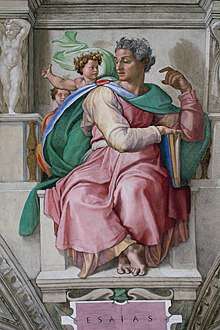
Twelve prophetic figures
.jpg)
On the five pendentives along each side and the two at either end, Michelangelo painted the largest figures on the ceiling: twelve people who prophesied a Messiah. These twelve are seven male Prophets of Israel and five Sibyls, prophetesses of classical mythology. The Prophet Jonah is placed above the altar and the Zechariah at the further end. The other male and female figures alternate down each long side, each being identified by an inscription on a painted marble tablet supported by a putto.
- Jonah (IONAS) – above the altar[Fig 11]
- Jeremiah (HIEREMIAS) [Fig 12]
- Persian Sibyl (PERSICHA)[Fig 13]
- Ezekiel (EZECHIEL)[Fig 14]
- Erythraean Sibyl. (ERITHRAEA)[Fig 15]
- Joel (IOEL)[Fig 16]
- Zechariah (ZACHERIAS) – above the main door of the chapel[Fig 17]
- Delphic Sibyl. (DELPHICA)[Fig 18]
- Isaiah (ESAIAS)[Fig 19]
- Cumaean Sibyl. (CVMAEA)[Fig 20]
- Daniel (DANIEL)[Fig 21]
- Libyan Sibyl (LIBICA)[Fig 22]
Prophets
The seven prophets of Israel chosen for depiction on the ceiling include the four so-called Major prophets: Isaiah, Jeremiah, Ezekiel and Daniel. Of the remaining possibilities among the Twelve Minor Prophets, the three represented are Joel, Zechariah and Jonah. Although the prophets Joel and Zechariah are considered "minor" because of the comparatively small number of pages that their prophecy occupies in the Bible, each one produced prophesies of profound significance.
They are often quoted, Joel for his "Your sons and your daughters shall prophesy, your elderly shall dream dreams and your youth shall see visions".[Src 4] These words are significant for Michelangelo's decorative scheme, where women take their place among men and the youthful Daniel sits across from the brooding Jeremiah with his long white beard.
Zechariah prophesied, "Behold! Your King comes to you, humble and riding on a donkey".[Src 5][61] His place in the chapel is directly above the door through which the Pope is carried in procession on Palm Sunday, the day on which Jesus fulfilled the prophecy by riding into Jerusalem on a donkey and being proclaimed King.[62]
Jonah is of symbolic and prophetic significance, which was commonly perceived and had been represented in countless works of art including manuscripts and stained glass windows.[52] Through his reluctance to obey God, he was swallowed by a "mighty fish".[lower-alpha 12] He spent three days in its belly and was eventually spewed up on dry land where he went about God's business.[Src 6] Jonah was thus seen as presaging Jesus, who having died by crucifixion, spent part of three days in a tomb and was raised on the third day.[Src 7] So, on the ceiling of the Sistine Chapel, Jonah, with the "great fish" beside him and his eyes turned towards God the Creator,[Fig 11] represents a "portent" of the Passion[63] and Resurrection of Christ.[61] The Jonah placed right over the altar activated the Passion motif. "When Perugino's altar painting was removed and ... Last Judgement fresco came to cover the altar wall",[63] after at least twenty five years Michelangelo depicted Christ just below Jonah: not only for his role as precursor of Christ, Christianity and Christocentrism, but also because his powerful torsion of the body, bent backwards from the bust to the eyes and with his forefingers that now point the glorious Jesus to the characters of the ceiling, assumes a function of link between the Old and New Testament.
In Vasari's description of the Prophets and Sibyls he is particularly high in his praise of Isaiah:[Fig 19] "Anyone who studies this figure, copied so faithfully from nature, the true mother of the art of painting, will find a beautifully composed work capable of teaching in full measure all the precepts to be followed by a good painter."[16]


Sibyls
The Sibyls were prophetic women who were resident at shrines or temples throughout the Classical World. The five depicted here are each said to have prophesied the birth of Christ. The Cumaean Sibyl, for example, is quoted by Virgil in his Fourth Eclogue as declaring that "a new progeny of Heaven" would bring about a return of the "Golden Age". This was interpreted as referring to Jesus.[64]
In Christian doctrine, Christ came not just to the Jews but also to the Gentiles. It was understood that, prior to the Birth of Christ, God prepared the world for his coming. To this purpose, God used Jews and Gentiles alike. Jesus would not have been born in Bethlehem (where it had been prophesied that his birth would take place),[Src 8] except for the fact that the pagan Roman Emperor Augustus decreed that there should be a census.[Src 9] Likewise, when Jesus was born, the announcement of his birth was made to rich and to poor, to mighty and to humble, to Jew and to Gentile. The Three Wise Men (the "Magi" of the Bible) who sought out the infant King with precious gifts were pagan foreigners.[Src 10]
In the Roman Catholic Church, where there was an increasing interest in the remains of the city's pagan past, where scholars turned from reading Mediaeval ecclesiastical Latin texts to classical Latin and the philosophies of the Classical world were studied along with the writings of St Augustine, the presence, in the Sistine Chapel of five pagan prophets is not surprising.[65]
It is not known why Michelangelo selected the five particular Sibyls that were depicted, given that, as with the Minor Prophets, there were ten or twelve possibilities. It is suggested by the Jesuit theologian John W. O'Malley that the choice was made for a wide geographic coverage, with the Sibyls coming from Africa, Asia, Greece and Ionia.[64]
Vasari says of the Erythraean Sibyl[Fig 15] "Many aspects of this figure are of exceptional loveliness: the expression of her face, her headdress and the arrangement of her draperies: and her arms, which are bared, are as beautiful as the rest."[16]
.png)

.png)
Pendentives
In each corner of the chapel is a triangular pendentive filling the space between the walls and the arch of the vault and forming a doubled spandrel above the windows nearest the corners. On these curving shapes Michelangelo has painted four scenes from Biblical stories that are associated with the salvation of Israel by four great male and female heroes of the Jews: Moses, Esther, David and Judith.[66] The first two stories were both seen in Mediaeval and Renaissance theology as prefiguring the Crucifixion of Jesus. The other two stories, those of David and Judith, were often linked in Renaissance art, particularly by Florentine artists as they demonstrated the overthrow of tyrants, a popular subject in the Republic.
- The Brazen Serpent
- The Punishment of Haman
- David and Goliath
- Judith and Holofernes
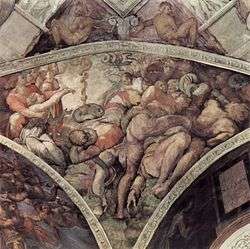
In the story of the Brazen Serpent, the people of Israel become dissatisfied and grumble at God. As punishment they receive a plague of venomous snakes. God offers the people relief by instructing Moses to make a snake of brass and set it up on a pole, the sight of which gives miraculous healing.[Src 11] Michelangelo chooses a crowded composition, depicting a dramatic mass of suffering men, women, and writhing snakes, separated from redeemed worshippers by the snake before an epiphanic light.[Fig 23]
John Ruskin compared Michelangelo's Brazen Serpent scene favourably to the canonical classical statue group Laocoön and His Sons, which Michelangelo saw on its discovery in 1506 together with Giuliano da Sangallo and his son.[67][68] Both works are crowded compositions of figures attacked by supernatural reptiles: the "fiery serpents" of the Book of Numbers and the sea-monsters of Virgil's Aeneid. But Ruskin preferred the sublimity expressed by Michelangelo's "gigantic intellect" in "the grandeur of the plague itself, in its multitudinous grasp, and its mystical salvation" and his "awfulness and quietness" to the "meagre lines and contemptible tortures of the Laocoön" and argued that "the grandeur of this treatment results, not merely from choice, but from a greater knowledge and more faithful rendering of truth".[67] Attacking the sculpture's unnaturalistic snakes as "pieces of tape with heads to them" and criticizing the unrealistic struggle, he contrasts:[67]
... the accuracy of Michael Angelo in the rendering of these circumstances; the binding of the arms to the body, and the knotting of the whole mass of agony together, until we hear the crashing of the bones beneath the grisly sliding of the engine folds. Note also the expression in all the figures of another circumstance, the torpor and cold numbness of the limbs induced by the serpent venom, which, though justifiably over-looked by the sculptor of the Laocoön, as well as by Virgil — in consideration of the rapidity of the death by crushing, adds infinitely to the power of the Florentine's conception.
— John Ruskin, Modern Painters, vol. 3, ch. VII., 1856.
In the Book of Esther it is related that Haman, a public servant, plots to get Esther's husband, the King of Persia, to slay all the Jewish people in his land. The King, who is going over his books during a sleepless night, realizes something is amiss. Esther, discovering the plot, denounces Haman, and her husband orders his execution on a scaffold he has built. The King's eunuchs promptly carry this out.[Src 12] Michelangelo shows Haman crucified with Esther looking at him from a doorway, the King giving orders in the background.[Fig 24]
In David and Goliath, the shepherd boy, David, has brought down the towering Goliath with his sling, but the giant is alive and is trying to rise as David forces his head down to chop it off.[69][Fig 25]
Judith and Holofernes depicts the episode in the Book of Judith. As Judith loads the enemy's head onto a basket carried by her maid and covers it with a cloth, she looks towards the tent,[69] apparently distracted by the limbs of the decapitated corpse flailing about.[Fig 26]
There are obvious connections in the design of the Slaying of Holofernes and the Slaying of Haman at the opposite end of the chapel. Although in the Holofernes picture the figures are smaller and the space less filled, both have the triangular space divided into two zones by a vertical wall, allowing us to see what is happening on both sides of it. There are actually three scenes in the Haman picture because as well as seeing Haman punished, we see him at the table with Esther and the King and get a view of the King on his bed.[69] Mordechai sits on the steps, making a link between the scenes.[70]
While the Slaying of Goliath is a relatively simple composition with the two protagonists centrally placed and the only other figures being dimly seen observers, the Brazen Serpent picture is crowded with figures and separate incidents as the various individuals who have been attacked by snakes struggle and die or turn toward the icon that will save them. This is the most Mannerist of Michelangelo's earlier compositions at the Sistine Chapel,[69]picking up the theme of human distress begun in the Great Flood scene and carrying it forward into the torment of lost souls in the Last Judgement, which was later painted below.
Ancestors of Christ
Subject
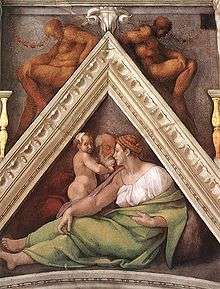
Between the large pendentives that support the vault are windows, six on each side of the chapel. There were two more windows in each end of the chapel, now closed, and those above the High Altar covered by the Last Judgement. Above each window is an arched shape, referred to as a lunette and above eight of the lunettes at the sides of the chapel are triangular spandrels filling the spaces between the side pendentives and the vault, the other eight lunettes each being below one of the corner pendentives.
Michelangelo was commissioned to paint these areas as part of the work on the ceiling. The structures form visual bridges between the walls and the ceiling, and the figures which are painted on them are midway in size (approximately 2 metres high) between the very large prophets and the much smaller figures of Popes which had been painted to either side of each window in the 15th century.[71] Michelangelo chose the Ancestors of Christ as the subject of these images,[72] thus portraying Jesus' physical lineage, while the papal portraits are his spiritual successors, according to Church doctrine.[73] (see gallery)
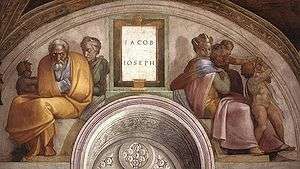
Centrally placed above each window is a faux marble tablet with a decorative frame. On each is painted the names of the male line by which Jesus, through his Earthly father, Joseph, is descended from Abraham, according to the Gospel of Matthew.[lower-alpha 14] However, the genealogy is now incomplete, since the two lunettes of the windows in the Altar wall were destroyed by Michelangelo when he returned to the Sistine Chapel in 1537 to paint The Last Judgement.[74] Only engravings, based on a drawing that has since been lost, remain of them.[Fig 27] The sequence of tablets seems a little erratic as one plaque has four names, most have three or two, and two plaques have only one. Moreover, the progression moves from one side of the building to the other, but not consistently, and the figures the lunettes contain do not coincide closely with the listed names. These figures vaguely suggest various family relationships; most lunettes contain one or more infants, and many depict a man and a woman, often sitting on opposing sides of the painted plaque that separates them. O'Malley describes them as "simply representative figures, almost ciphers".[72]
There is also an indeterminate relationship between the figures in the spandrels and the lunettes beneath them. Because of the constraints of the triangular shape, in each spandrel the figures are seated on the ground. In six of the eight spandrels the compositions resemble traditional depictions of the Flight into Egypt. Of the two remaining, one shows a woman with shears trimming the neck of a garment she is making while her toddler looks on.[Fig 28] The Biblical woman who is recorded as making a new garment for her child is Hannah, the mother of Samuel, whose child went to live in the temple, and indeed, the male figure in the background is wearing a distinctive hat that might suggest that of a priest.[Src 13] The other figure who differs from the rest is a young woman who sits staring out of the picture with prophetic intensity. Her open eyes have been closed in the restoration.[Fig 29]
Treatment
Michelangelo's depiction of the Genealogy of Jesus departs from an artistic tradition for this topic that was common in the Middle Ages, especially in stained-glass windows. This so-called Jesse Tree shows Jesse lying prone and a tree growing from his side with the ancestors on each branch, in a visual treatment of a biblical verse.[Src 14]
The figures in the lunettes appear to be families, but in every case they are families that are divided. The figures in them are physically divided by the name tablet but they are also divided by a range of human emotions that turn them outward or in on themselves and sometimes towards their partner with jealousy, suspicion, rage or simply boredom. In them Michelangelo has portrayed the anger and unhappiness of the human condition, painting "the daily round of merely domestic life as if it were a curse".[75] In their constraining niches, the ancestors "sit, squat and wait".[76] Of the fourteen lunettes, the two that were probably painted first, the families of Eleazar and Mathan and of Jacob and his son Joseph are the most detailed. They become progressively broader towards the altar end, one of the last being painted in only two days.[lower-alpha 15]
The Eleazar and Mathan picture contains two figures with a wealth of costume detail that is not present in any other lunette. [Fig 30] The female to the left has had as much care taken with her clothing as any of the Sibyls. Her skirt is turned back showing her linen petticoat and the garter that holds up her mauve stockings and cuts into the flesh. She has a reticule and her dress is laced up under the arms. On the other side of the tablet sits the only male figure among those on the lunettes who is intrinsically beautiful. This blond young man, elegantly dressed in white shirt and pale green hose, with no jerkin but a red cloak, postures with an insipid and vain gesture, in contrast to the Ignudi which he closely resembles.
Prior to restoration, of all the paintings in the Sistine Chapel, the lunettes and spandrels were the dirtiest.[77] Added to this, there has always been a problem of poor daytime visibility of the panels nearest the windows because of halination.[lower-alpha 16] Consequently, they were the least well known of all Michelangelo's publicly accessible works. The recent restoration has made these masterly studies of human nature and inventive depiction of the human form known once more.

Ignudi
The ignudi[lower-alpha 17] are the 20 athletic, nude males that Michelangelo painted as supporting figures at each corner of the five smaller narrative scenes that run along the centre of the ceiling. The figures hold or are draped with or lean on a variety of items which include pink ribbons, green bolsters and enormous garlands of acorns.[lower-alpha 10]
The Ignudi, although all seated, are less physically constrained than the Ancestors of Christ. While the pairs of the monochrome male and female figures above the spandrels are mirrors of each other, these Ignudi are all different. In the earliest paintings, they are paired, their poses being similar but with variation. These variations become greater with each pair until the postures of the final four bear no relation to each other whatsoever. The meaning of these figures has never been clear. They are certainly in keeping with the Humanist acceptance of the classical Greek view that "the man is the measure of all things".[78]
Catholic theologian John W. O'Malley argues that the ignudi represent angels: Michelangelo later included more than forty angels in his fresco of the Last Judgement, on altar wall of the Chapel, which O'Malley claims resemble the ignudi.[18][79]
Their painting demonstrates, more than any other figures on the ceiling, Michelangelo's mastery of anatomy and foreshortening and his enormous powers of invention.[lower-alpha 18] In their reflection of classical antiquity they resonate with Pope Julius' aspirations to lead Italy towards a new 'age of gold'; at the same time, they staked Michelangelo's claim to greatness.[80] However, a number of critics were angered by their presence and nudity, including Pope Adrian VI who wanted the ceiling stripped.


Stylistic analysis and artistic legacy
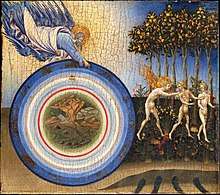


Michelangelo was the artistic heir to the great 15th-century sculptors and painters of Florence. He learned his trade first under the direction of a masterly fresco painter, Domenico Ghirlandaio, known for two great fresco cycles in the Sassetti Chapel and Tornabuoni Chapel, and for his contribution to the cycle of paintings on the walls of the Sistine Chapel. As a student Michelangelo studied and drew from the works of the two most renowned Florentine fresco painters of the early Renaissance, Giotto and Masaccio.[81] Masaccio's figures of Adam and Eve being expelled from the Garden of Eden had a profound effect on the depiction of the nude in general, and in particular on the use of the nude figure to convey human emotion.[Fig 31] Helen Gardner says that in the hands of Michelangelo "the body is simply the manifestation of the soul, or of a state of mind and character".[81]
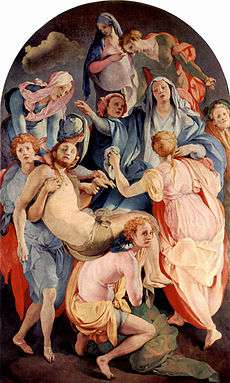
Michelangelo was also almost certainly influenced by the paintings of Luca Signorelli[81] whose paintings, particularly the Death and Resurrection Cycle in Orvieto Cathedral contain a great number of nudes and inventive figurative compositions.[Fig 32] In Bologna, Michelangelo saw the relief sculptures of Jacopo della Quercia around the Porta Magna of the minor basilica. In Michelangelo's depiction of the Creation of Eve the whole composition, the form of the figures and the relatively conservative concept of the relationship between Eve and her Creator adheres closely to Jacopo's design.[20] Other panels on the ceiling, most particularly the iconic Creation of Adam show "... unprecedented invention".[20]
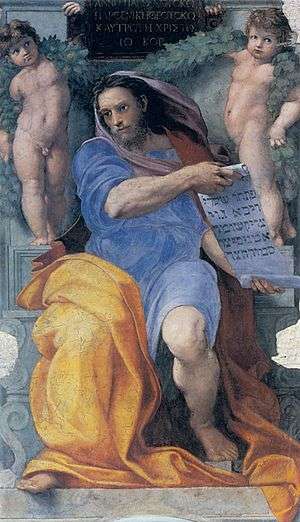
Older depictions of the creation scenes had depicted God as mostly immobile, a static, enthroned image whose activity was indicated by a gesture of the hand, as in the creation scenes of the mediaeval Byzantine-style mosaics of Monreale Cathedral.[82] Michelangelo, influenced by the Paradiso of Dante Alighieri, shows God in full-bodied movement, an innovation Giovanni di Paolo had made in his Creation and Expulsion from Paradise. Paolo Uccello also had shown some movement in his scene of the creation of Adam and Eve in the cloister of Santa Maria Novella.[83] In di Paolo's painting, as in Michelangelo's fresco, God is accompanied and apparently carried aloft by attendant putti.[83] Raphael employed movement somewhat more in his contemporary The Prime Mover, next door to the Sistine Chapel in the stanza della segnatura and painted 1509–'11; Perugino's slightly earlier Creator in fresco, in the room named for Raphael's Incendio del Borgo, shows a seated, static divinity.[83]
The ceiling of the Sistine Chapel was to have a profound effect upon other artists, even before it was completed. Vasari, in his Life of Raphael, tells us that Bramante, who had the keys to the chapel, let Raphael in to examine the paintings in Michelangelo's absence. On seeing Michelangelo's prophets, Raphael went back to the picture of the Prophet Isaiah that he was painting on a column in the Church of Sant'Agostino and, according to Vasari, although it was finished, he scraped it off the wall and repainted it in a much more powerful manner, in imitation of Michelangelo.[16] John W. O'Malley points out that even earlier than the Isaiah is Raphael's inclusion of the figure of Heraclitus in the School of Athens, a brooding figure similar to Michelangelo's Jeremiah, but with the countenance of Michelangelo himself, and leaning on a block of marble.[84][Fig 33]
There was hardly a design element on the ceiling that was not subsequently imitated: the fictive architecture, the muscular anatomy, the foreshortening, the dynamic motion, the luminous colouration, the haunting expressions of the figures in the lunettes, the abundance of putti. Gabriele Bartz and Eberhard König have said of the ignudi, "There is no image that has had a more lasting effect on following generations than this. Henceforth similar figures disported themselves in innumerable decorative works, be they painted, formed in stucco or even sculpted."[85]
Within Michelangelo's own work, the chapel ceiling led to the later and more Mannerist painting of the Last Judgement in which the crowded compositions gave full rein to his inventiveness in painting contorted and foreshortened figures expressing despair or jubilation. Among the artists in whose work can be seen the direct influence of Michelangelo are Pontormo, Andrea del Sarto, Correggio, Tintoretto, Annibale Carracci, Paolo Veronese and El Greco.
In January 2007, it was claimed that as many as 10,000 visitors passed through the Vatican Museums in a day and that the ceiling of the Sistine Chapel is the biggest attraction. The Vatican, anxious at the possibility that the newly restored frescoes will suffer damage, announced plans to reduce visiting hours and raise the price in an attempt to discourage visitors.[86]
Five hundred years earlier Vasari had said "The whole world came running when the vault was revealed, and the sight of it was enough to reduce them to stunned silence."[16]

Restoration
The main panels of the ceiling had been so aged by candle smoke as to make their colors significantly muted.[38] After preliminary tests taking place in 1979, the ceiling was restored between 1980 and 1992,[38] The first stage of restoration, the work upon Michelangelo's lunettes, was performed in October 1984. The work then proceeded on the ceiling, completed in December 1989, and from there to The Last Judgement. The restoration was unveiled by Pope John Paul II on 8 April 1994.
The restoration has removed the filter of grime to reveal colours closer to the paintings at the time of their completion.[87] The ceiling now appears to depict daytime scenes and a springlike atmosphere with bright saturated colours,[lower-alpha 19] The restoration was met with both praise and criticism. Critics assert that much original work by Michelangelo—in particular pentimenti, highlights and shadows, and other detailing painted a secco—was lost in the removal of various accretions.[88]
The restoration of the wall frescoes by Botticelli, Domenico Ghirlandaio, Perugino and others was unveiled on 11 December 1999.[87] The restoration team consisted of Gianluigi Colalucci, Maurizio Rossi, Piergiorgio Bonetti, Bruno Baratti and others.
Quotations
Vasari
- The work has proved a veritable beacon to our art, of inestimable benefit to all painters, restoring light to a world that for centuries had been plunged into darkness. Indeed, painters no longer need to seek for new inventions, novel attitudes, clothed figures, fresh ways of expression, different arrangements, or sublime subjects, for this work contains every perfection possible under those headings.[16]
Without having seen the Sistine Chapel one can form no appreciable idea of what one man is capable of achieving.
— Johann Wolfgang Goethe, 23 August 1787, [89]
Waldemar Januszczak
The art critic and television producer Waldemar Januszczak wrote that when the Sistine Chapel ceiling was recently cleaned, he "was able to persuade the man at the Vatican who was in charge of Japanese TV access to let me climb the scaffold while the cleaning was in progress."
- I sneaked up there a few times. And under the bright, unforgiving lights of television, I was able to encounter the real Michelangelo. I was so close to him I could see the bristles from his brushes caught in the paint; and the mucky thumbprints he'd left along his margins. The first thing that impressed me was his speed. Michelangelo worked at Schumacher pace. ... I also enjoyed his sense of humour, which, from close up, turned out to be refreshingly puerile. If you look closely at the angels who attend the scary prophetess on the Sistine ceiling known as the Cumaean Sibyl, you will see that one of them has stuck his thumb between his fingers in that mysteriously obscene gesture that visiting fans are still treated to today at Italian football matches.[90]
Gabriele Bartz and Eberhard König
- In a world where all experience was based in the glorious lost past of Antiquity, he made a new beginning. Michelangelo, more even than Raphael or Leonardo, embodies a standard of artistic genius which reveals a radically changed image of human beings and their potential ...[20]
- It seems that Michelangelo, in his own way, allowed himself to be guided by the evocative words of the Book of Genesis which, as regards the creation of the human being, male and female, reveals: 'The man and his wife were both naked, yet they felt no shame'. The Sistine Chapel is precisely – if one may say so – the sanctuary of the theology of the human body. In witnessing to the beauty of man created by God as male and female, it also expresses in a certain way, the hope of a world transfigured, the world inaugurated by the Risen Christ.[91]
See also
- Index of Vatican City-related articles
Notes
- It is unknown and the subject of speculation among art historians whether Michelangelo was really able to paint the ceiling completely as he wished.[18]
- This was epitomised by Giovanni Pico della Mirandola's Oration on the Dignity of Man. O'Malley, p. 122.
- Vasari interpreted the Sacrifice of Noah as that of Cain and Abel
- Anthony Bertram (1970) discusses this as a hidden layer in the meanings of these works and notes that "The principal opposed forces in this conflict were his passionate admiration for classical beauty and his profound, almost mystical Catholicism, his homosexuality, and his horror of carnal sin combined with a lofty Platonic concept of love."
- E.g., in the Creation of Adam
- Vasari says that Michelangelo, even as a boy, had "the ability and judgement, fire and boldness to improve upon the work of his master".
- It now stands further from the altar.[40]
- These are not marked on the drawn plan but are clearly visible in the photographs.
- E.g. "egg and dart", "bead and reel".
- Sixtus IV, and Julius II were both of the Della Rovere family. "Rovere" in Italian means "Oak", Quercus robur.
- The scallop shell (and pearl) is a symbol of the doctrine of the Incarnation in renaissance and baroque art.
- Usually interpreted as a whale
- In accordance with chapter 9 of the apocryphal Gospel of James, where Joseph says "I am an old man", Renaissance art used to depict him in this way. See also The Cherry-Tree Carol: "Joseph was an old man, and a bad old man was he, when he wedded Mary in the land of Galilee" (English 15th century). Traditionally, he is often dressed in a blue garment with a yellow cloak, e.g. Fra Angelico's Adoration.
- The lunettes specifically follow the genealogy according to Matthew, not the somewhat longer genealogy according to Luke. Over large stretches, the two genealogies differ, and choosing Matthew's over Luke's has interesting theological implications (see Genealogy of Jesus).
- This is apparent from the giornata, the area plastered and painted in a single day.
- "Halination" is the effect of bright areas blurring over less bright ones.
- Singular: Ignudo; from the Italian adjective nudo, meaning "naked"
- See Vasari's comments under "Quotations".
- Sources showing the work before the restoration was complete feature colours which are more saturated than they are in the final product.[38]
References
- Shearman 1986, pp. 22–36
- Shearman 1986b, pp. 38–87
- O'Malley 1986, pp. 92–148
- Shaw, Christine (1996). Julius II: The Warrior Pope. Oxford: Blackwell. ISBN 978-0-631-20282-0.
- Partridge 1996, p. 15.
- Chilvers, Ian, ed. (2009). "Michelangelo (Michelangelo Buonarroti)". The Oxford Dictionary of Art and Artists (4th ed.). Online: Oxford University Press. doi:10.1093/acref/9780199532940.001.0001. ISBN 978-0-19-953294-0.
- Campbell, Gordon, ed. (2005). "Michelangelo Buonarroti or Michelagnolo Buonarroti". The Oxford Dictionary of the Renaissance (Online ed.). Oxford University Press. doi:10.1093/acref/9780198601753.001.0001. ISBN 978-0-19-860175-3.
- Osborne, Harold; Brigstocke, Hugh (2003). "Michelangelo Buonarroti". In Brigstocke, Hugh (ed.). The Oxford Companion to Western Art (Online ed.). Oxford University Press. doi:10.1093/acref/9780198662037.001.0001. ISBN 978-0-19-866203-7.
- Pater, Walter (1893). The Renaissance: Studies in Art and Poetry (4th ed.). Courier Corporation [2005, 2013 reprint]. p. 55. ISBN 978-0-486-14648-5.
- Chilvers, Ian, ed. (2004). "Michelangelo (Michelangelo Buonarroti)". The Oxford Dictionary of Art (3 ed.). Online: Oxford University Press. doi:10.1093/acref/9780198604761.001.0001. ISBN 978-0-19-860476-1.
- Vasari, Giorgio (1991). The Lives of the Artists. Oxford World's Classics. Translated by Bondanella, Peter; Conway Bondanella, Julia. Oxford University Press. p. 440. ISBN 978-0-19-953719-8.
- Goldscheider 1953.
- Shearman 1986b, pp. 45–47.
- Partridge, 1996, p. 10.
- Partridge, 1996, p. 11.
- Vasari 1568.
- Pfisterer, Ulrich (2018). The Sistine Chapel: Paradise in Rome. Grand Rapid, Michigan: Getty Publications. pp. 53–56. ISBN 978-1-60606-553-2.
- O'Malley 1986, p. 104.
- Partridge 1996, p. 13.
- Bartz 1998.
- Graham-Dixon 2008, p. 181ff.
- Tallis, Raymond (2010). Michelangelo's Finger. An Exploration of Everyday Transcendence. Ormond House in Bloomsbury, London Borough of Camden: Atlantic Books. p. v. ISBN 978-1-848-87552-4.
- Clark, Kenneth (1956). The Nude: A Study in Ideal Form. Pantheon Books (reprint). p. 208. ISBN 9781567311235.
- Blech, Benjamin. The Sistine Secrets: Michelangelo's Forbidden Messages in the Heart of the Vatican, HarperOne, (2009)
- wrote Foreword to Blech's book, Enrico bruschini website Archived 2015-11-14 at the Wayback Machine
- Gardner, Art Through the Ages, pp. 469–472
- O'Malley, p.112
- Gardner, p.466–467
- Aston 1979, pp. 111–112
- O'Malley, pp. 102–110
- O'Malley, p. 105
- Pfisterer, Ulrich (2018). The Sistine Chapel: Paradise in Rome. Los Angeles: Getty Publications. pp. 47–52. ISBN 978-1-60606-553-2.
- Thompson, Bard (1996). Humanists and Reformers: A History of the Renaissance and Reformation. Grand Rapids, Michigan: Wm. B. Eerdmans Publishing. pp. 266–267. ISBN 978-0-8028-6348-5.
- Mancinelli 1986, pp. 220–259
- Condivi 1553.
- "Fresco | Artsy". Artsy. Retrieved April 30, 2019.
- Goldscheider 1951.
- De La Croix, Horst; Tansey, Richard G.; Kirkpatrick, Diane (1991). Gardner's Art Through the Ages (9th ed.). Harcourt Brace Jovanovich. pp. 655–57. ISBN 0155037692.
- Ramsden, E. H. (1978) [1963]. Michelangelo (The Great Artists: A library of their lives, times and paintings. New York: Funk & Wagnalls. p. XIII.
- Ramsden, E. H. (1978) [1963]. Michelangelo (The Great Artists: A library of their lives, times and paintings. New York: Funk & Wagnalls. p. 3.
- Bartz and König, p.55
- Barkan, Leonard (2011). Michelangelo: A Life on Paper. Princeton University Press. pp. 87–92. ISBN 978-0-691-14766-6.
- Barkan, Leonard (2011). Michelangelo: A Life on Paper. Princeton University Press. p. 90. ISBN 978-0-691-14766-6.
- Buonarroti, Michelangelo (1960). Girardi, Enzo Noè (ed.). Rime (1st ed.). Bari: G. Laterza. pp. 4–5, 158–159.
- Buonarroti, Michelangelo (1878). The Sonnets of Michael Angelo Buonarroti and Tommaso Campanella. London: Smith, Elder, & Co. pp. 35.
- Shearman 1986, pp. 29–30
- O'Malley, p.100
- Partridge 1996, p. 9
- O'Malley, p.95
- O'Malley, pp. 104–105, 160–161
- Paoletti and Radke p.402–403
- See Poor Man's Bible
- Pater, Walter (1893). The Renaissance: Studies in Art and Poetry (4th ed.). Courier Corporation [2005, 2013 reprint]. p. 55. ISBN 978-0-486-14648-5.
- Pater, Walter (1893). The Renaissance: Studies in Art and Poetry (4th ed.). Courier Corporation [2005, 2013 reprint]. p. 52. ISBN 978-0-486-14648-5.
- Bartz and König, p. 54
- Gardner, p. 467
- Rupp 2014
- Charles de Tolnay, translated by Nan Buranelli, The Art and Thought of Michelangelo, Pantheon, (1964)
- Pfisterer, Ulrich (2018). The Sistine Chapel: Paradise in Rome. Getty Publications. p. 61. ISBN 978-1-60606-553-2.
- Shearman 1986.
- O'Malley, pp. 106–107
- O'Malley, pp. 120–22
- Jaritz, p. 16
- O'Malley, p.116
- O'Malley, pp. 107–117
- Paoletti and Radke, p. 407
- Ruskin, John (1872). Modern Painters. 3. New York: J. Wiley. pp. 68–69.
- Barkan, Leonard (1999). Unearthing the Past: Archaeology and Aesthetics in the Making of Renaissance Culture. New Haven: Yale University Press. pp. 1–4. ISBN 0-300-07677-0. OCLC 41118690.
- O'Malley, picture captions, pp. 162–169
- Bartz and König, p.56
- Mancinelli, p. 238
- O'Malley, p.170–174
- Graham-Dixon 2008, p. 137
- Graham-Dixon 2008, p. 138.
- Graham-Dixon 2008, p. 141
- Bartz and König, p. 44
- Mancinelli, pp.234–236
- Protagoras of Abdera, (c. 480–410 B.C.).
- Hersey 1993.
- Graham-Dixon 2008, p. 136
- Gardner 1970.
- Boitani, Piero (2016). "The unmoved mover begins to move: literary and artistic renderings of the Christian Bible". In Cohen, Mordechai Z.; Berlin, Adele (eds.). Interpreting Scriptures in Judaism, Christianity and Islam: Overlapping Inquiries. Cambridge University Press. pp. 97–99. ISBN 978-1-316-54616-1.
- Boitani, Piero (2016). "The unmoved mover begins to move: literary and artistic renderings of the Christian Bible". In Cohen, Mordechai Z.; Berlin, Adele (eds.). Interpreting Scriptures in Judaism, Christianity and Islam: Overlapping Inquiries. Cambridge University Press. pp. 106–112. ISBN 978-1-316-54616-1.
- O'Malley, pp.156–158
- Bartz and König, pages 45 and 52
- Richard Owen, "Vatican puts a squeeze on visitors", Timesonline, January 6, 2007.
- Pietrangeli 1994
- Beck 1995.
- Letter. Original: (in German) Ich kann euch nicht ausdrücken, wie sehr ich euch zu mir gewünscht habe, damit ihr nur einen Begriff hättet, was ein einziger und ganzer Mensch machen und ausrichten kann; ohne die Sixtinische Kapelle gesehen zu haben, kann man sich keinen anschauenden Begriff machen, was ein Mensch vermag. Italian Journey, 2nd journey to Rome.Italienische Reise, Teil 21
- Januszczak 2006
- John Paul II 1994
Reference images
- First Day of Creation, in context with medallions and Ignudi (restored)
- Dividing Water and Heavens, in context with medallions and Ignudi (restored)
- Creation of the Earth and the celestial bodies, (restored)
- God creating Eve from the side of the sleeping Adam, in context with medallions and Ignudi (before restoration)
- Adam and Eve: temptation and banishment (restored)
- The Sacrifice of Noah (restored)
- The Great Flood (before restoration)
- Noah's drunkenness in context, with medallions and Ignudi (before restoration)
- The "Uriah" medallion
- The incomplete medallion on the left-hand side of the "Separation of the Waters" panel
- The prophet Jonah (restored)
- The prophet Jeremiah (restored)
- The Persian Sibyl (restored)
- The prophet Ezekiel (restored)
- The Erithraean Sibyl (before restoration)
- The prophet Joel (before restoration)
- The prophet Zechariah (before restoration)
- The Delphic Sibyl (restored)
- The prophet Isaiah (restored)
- The Cumean Sibyl (restored)
- The prophet Daniel (before restoration)
- The Libyan Sibyl (restored)
- The Brazen Serpent (Before restoration)
- The crucifixion of Haman (Before restoration)
- David slaying Goliath (Before restoration)
- Judith carrying the head of Holofernes (Before restoration)
- The destroyed lunettes: Abraham / Isaac / Jacob / Judah and Pharez / Hezron / Ram, engravings by William Young Ottley.
- Woman cutting garment The "Salmon Spandrel" (restored)
- The Blessed Virgin Mary(?) looking from a spandrel before and after restoration.
- Eleazar and Mathan lunette (before restoration)
- Masaccio: The Expulsion from the Garden of Eden fresco, 208 cm × 88 cm (82 in × 35 in) Cappella Brancacci, Santa Maria del Carmine, Florence
- Luca Signorelli: Resurrection of the Flesh (1499–1502) Chapel of San Brizio, Duomo, Orvieto
- Raphael (ca. 1509) Heraclitus Detail from the School of Athens, a portrait of Michelangelo
Biblical sources
- Genesis, chapter 1
- Genesis, chapters 1–3
- Genesis, chapters 6–9
- Joel, chapter 2, verse 28.
- Zechariah, chapter 9, verse 9; Matthew, chapter 21, verses 4–5
- The Book of Jonah
- Gospel of Matthew 12:39–40.
- Book of Micah, chapter 5, verse 2; Gospel of Matthew, chapter 2, verse 6.
- Gospel of Luke
- Gospel of Matthew
- The Book of Numbers, chapter 21:4–9
- The Book of Esther
- First Book of Samuel, chapter 2:18
- Isaiah 11:1
Bibliography
- Aston, Margaret (1979) "The fifteenth century: the prospect of Europe". W.W. Norton, New York. ISBN 0-393-95097-2
- Bartz, Gabriele; König, Eberhard (1998). Michelangelo, Könemann. ISBN 3-8290-0253-X
- Beck, James; Daley, Michael (1995). Art Restoration, the Culture, the Business and the Scandal, W.W. Norton. ISBN 0-393-31297-6
- Bertram, Anthony (1970). Michelangelo, 1970, Studio Vista. ISBN B00071KTVA
- Buonarotti, Michelangelo; Campanella, Tommaso (1878). The Sonnets of Michael Angelo Buonarotti and Tommaso Campanella Now For the First Time Translated into Rhymed English. Project Gutenberg EBooks. 10314. Translated by John Addington Symonds. Retrieved 2 June 2009.
- Condivi, Ascanio (1553). Life of Michelangelo
- Efetov, Konstantin (2006), A shocking secret of the Sistine Chapel, Simferopol: CSMU Press, ISBN 966-2969-17-9
- Freidenthal, Richard (1963). Letters of the Great Artists, 1963, Thames and Hudson
- Gardner, Helen (1970) Art through the Ages, Harcourt, Brace and World. ISBN 978-0-15-508315-8
- Giacometti, Massimo (1984). The Sistine Chapel, a collection of essays on aspects of the chapel, its decoration and the restoration of Michelangelo's frescoes, by Carlo Pietrangeli, André Chastel, John Shearman, John O'Malley S.J., Pierluigi de Vecchi, Michael Hirst, Fabrizio Mancinelli, Gianluigi Colallucci, and Franco Bernabei. 1984, Harmony Books. ISBN 0-517-56274-X
- Graham-Dixon, Andrew (2008). Michelangelo and the Sistine Chapel. London: Weidenfeld & Nicolson. ISBN 978-0-297-85365-7.
- Goldscheider, Ludwig (1951). Michelangelo: Drawings, Phaidon.
- Goldscheider, Ludwig (1953). Michelangelo: Paintings, Sculpture, Architecture, Phaidon.
- Hale, J.R. (1979). Renaissance Europe, 1480–1520, Fontana/Collins. ISBN 0-00-632435-5
- Hartt, Frederick and David G. Wilkins (2007). “Michelangelo 1505–1516”. History of Italian Renaissance Art (7th ed.). Pearson Education, Inc. pp. 496–512. ISBN 978-0-205-70581-8.
- Hersey, George L. (1993) High Renaissance Art in St. Peter's and the Vatican, University of Chicago Press. ISBN 0-226-32782-5
- Hirst, Michael (1986). in The Sistine Chapel, ed. Massimo Giacometti
- The Holy Bible, various authors, King James Version.
- Januszczak, Waldemar (March 5, 2006). "The Michelangelo code". The Sunday Times. London. Retrieved April 30, 2019. — via Waldemar Januszczak Archive
- Jaritz, Gerhard (2012). Ritual, Images, and Daily Life. The Medieval Perspective. Münster: LIT Verlag. p. 16. ISBN 978-3-643-90113-2.
- John Paul II (1994). "Homily of His Holiness John Paul II, 8 April 1994". Homily preached at the mass of to celebrate the unveiling of the restorations of Michelangelo's frescoes in the Sistine Chapel. Vatican Publishing House. Retrieved April 6, 2009.
- Mancinelli, Fabrizio (1986). in The Sistine Chapel, ed. Massimo Giacometti
- O'Malley, John (1986). The Theology behind Michelangelo's Ceiling in The Sistine Chapel, ed. Massimo Giacometti.
- Paoletti, John T.; Radke, Gary M. (2005). Art in Renaissance Italy, Laurence King. ISBN 1-85669-439-9
- Partridge, Loren (1996). Michelangelo. The Sistine Chapel Ceiling, Rome. New York: George Braziller. ISBN 0-8076-1315-0.
- Pietrangeli, Hirst and Colalucci, eds. (1994). The Sistine Chapel: A Glorious Restoration. Italy, Harry N Abrams
- Rupp, Rebecca (July 22, 2014). "The History of the "Forbidden" Fruit". National Geographic. Retrieved April 30, 2019.
- Shearman, John (1986) The Chapel of Sixtus IV in The Sistine Chapel, ed. Massimo Giacometti.
- Shearman, John (1986b) The Fresco Decoration of Sixtus IV in The Sistine Chapel, ed. Massimo Giacometti.
- Vasari, Giorgio (1568). Lives of the Artists, 'Michelangelo'. Trans. George Bull, 1965, Penguin Classics. ISBN 0-14-044164-6
- Vecchi, Pierluigi de, ed. (1994). The Sistine Chapel: A Glorious Restoration, Abrams. ISBN 0-8109-3840-5
External links
| Wikimedia Commons has media related to Sistine Chapel ceiling. |
- Vatican Museum
- Visual/Interactive Tour of the Sistine Chapel Ceiling and upper walls, with identifications and detail images
- Zoomable Panoramic View of the Sistine Chapel Ceiling (HTML5)
- Michelangelo's Ceiling of the Sistine Chapel, Smarthistory video (22:03)
- Models of wax and clay used by Michelangelo in making his sculpture and paintings
- Sistine Chapel Panoramas View
- The Sistine Ceiling and the Holy Spirit


